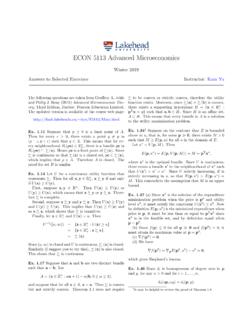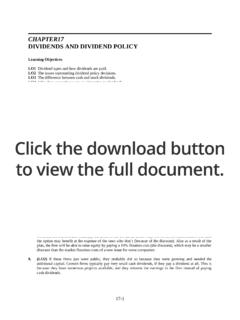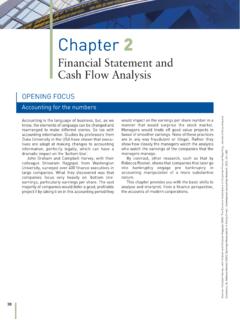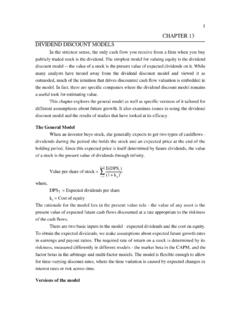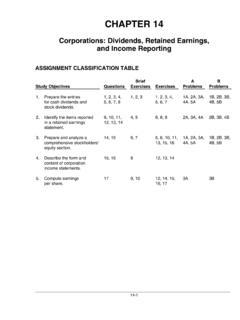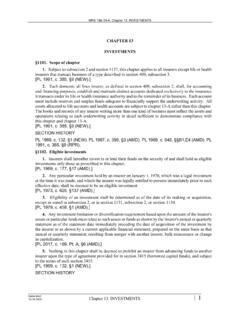Transcription of Dividend Policy - Lakehead University
1 Dividend PolicyGitman and Hennessey Chapter 11 Spring Relevance of Dividend Affecting Dividend of Dividend Forms of Corporate Distribution2 Dividend FundamentalsDividends are usually paid in are normally paid quarterly and, if conditions permit,increased once a for example that a corporation paid $ per quarter in2003. Its annual Dividend is then $ FundamentalsThe procedure for paying dividends is as follows:Declaration Date:Date at which the company announces it willpay a Date:Date at which the list of shareholderswho will receive the Dividend is Date:The convention is that the right to thedividend remains with the stock until two business daysbefore the holder-of-record date.
2 Whoever buys the stock onor after the ex- Dividend date does not receive the FundamentalsExampleDeclaration Date:On May 7, 2004, Sun Rype Productsannounced it will pay a quarterly Dividend of $ pershare. The payment will be made on June 15, Date:The Dividend will be paid toshareholders on record at close of business on May 31, Date:May 31 was a Monday so the ex-dividenddate in this example is May 27, FundamentalsJune 15 May 31 May 27 May 26 May 7 Declaration dateDividend goes with the stockEx- Dividend dateHolder-of-record datePayment date6 Dividend FundamentalsFall in Stock Price on the Ex- Dividend Date p0 stock price one day before the ex- Dividend datep0 stock price on ex- Dividend date (t=0)p0= t=1dt(1+rs)t p0=p0+d0 p0 p0= taxes, the stock price should fall byd0on theex- Dividend FundamentalsDividend Reinvestment Plans (DRIPs)
3 Many companies offer DRIPs, whereby shareholders can use thedividend received to purchase additional shares (even fractional)of the company without brokerage companies that offer DRIPs also offer share repurchaseplans (SPP), which allow shareholders to make optional cashcontributions that are eventually used to purchase of Dividend PolicyThe Residual Theory of DividendsOne school of thoughts, the residual theory of dividends,suggests that the Dividend paid bya firm be viewed as aresidual, the amount leftover after all acceptable investmentopportunities have been of Dividend PolicyThe Residual Theory of DividendsUsing this approach, the Dividend decision is done in three the optimal level of capital expenditures; the total amount of equity financing needed tosupport the expenditures.
4 Reinvested profits to meet the equity requirement. If theavailable reinvested profits are in excess of the equity need,then the surplus, the residual, is distributed to shareholdersas of Dividend PolicyThe Residual Theory of DividendsUnder the residual Dividend model, dividends are determined asfollows:Dividends=Net Income Target Equity Ratio Capital Needed11 Relevance of Dividend PolicyThe Residual Theory of DividendsSuppose a firm has a target equity ratio of 60% and needs tospend $50m on new firm 50=$30m in its net income is $100m, its Dividend will be100 30=$ capital requirements were $200m, the firm would not pay of Dividend PolicyThe Residual Theory of DividendsUnder the residual Dividend model, the better the firm sinvestment opportunities, the lower the Dividend the residual Dividend Policy rigidly would lead tofluctuating dividends.
5 Something investors don t of Dividend PolicyThe Residual Theory of DividendsTo satisfy shareholders taste for stable dividends, firms earnings and investment opportunities, on averageover the next five to ten years; this information to find out the average residual payoutratio; a target payout of Dividend PolicyDividend Irrelevance ArgumentsXYZ, an all-equity firm has 100 shares outstanding and acashflowof $10,000 (including liquidation) over the next two firm can then pay a Dividend of $100 per shares in each ofthese two periods, which gives a stock pricep0=d11+rs+d2(1+rs)2= +100( )2=$ the return required by shareholders (XYZ scost of capital when an all-equity firm).
6 15 Dividend Irrelevance TheorySuppose that XYZ wants to change its Dividend Policy . Insteadof paying $100 per year to each shareholder, it will pay $120 pershare the first year and whatever remains after liquidation of thefirm on the second finance the greater Dividend , XYZ has to either raise debt Irrelevance TheoryEquity Is IssuedIf equity is issued new shares have to be issued in exchange of100 20=$2,000after one is no increase in leverage and thus the new shareholderswill also require a return of 10%, a payment of $2,200 at theend of the second means that there will be10,000 2,200=$7.
7 800availableto the old shareholders at time Irrelevance TheoryEquity Is IssuedThe new stock price is thenp 0= +78( )2=$ , it has not Irrelevance TheoryEquity Is IssuedMore generally, consider a firm withn0shares outstanding andfor which the stock price isp0=d11+rs+d2(1+rs)2+p2(1+rs) that instead of payingd1in period 1, the firm decides toissue equity and pay a Dividend ofd1+ Irrelevance TheoryEquity Is IssuedThere is no change in leverage and thus shareholders requiredreturn remains the same, which means that the new shareholderswill receive(1+rs)n0xin period 2. Hence the period 2 Dividend will bed 2=d2 (1+rs)n0xn0=d2 (1+rs) Irrelevance TheoryEquity Is IssuedFollowing this decision, the firm s stock price isp 0=d1+x1+rs+d2 (1+rs)x(1+rs)2+p2(1+rs)2=d11+rs+x1+rs+d2 (1+rs)2 x1+rs+p2(1+rs)2=d11+rs+d2(1+rs)2+p2(1+rs )
8 2= Irrelevance TheoryDebt Is IssuedIf debt is issued to change the stream of Dividend payments, theninterest payments will have to be made in the to M&M Proposition I, this change in capital structuredoes not affect the value of the firm as a Irrelevance TheoryDebt Is IssuedLetVrepresent the value of the firm without debt (the base case).The firm s stock price is then initiallyp0=Vn0,which must also be equal to the present value of the Irrelevance TheoryDebt Is IssuedSuppose the firm sells debt to finance an extra Dividend of valuexthat will be paid to each shareholdersat time firm s assets remain unchanged and thus its cash flow fromassets also remains the value of debt in period 0 isD=n0x, the value of the firm isV, as before.
9 And the value of equity isE=V D=V Irrelevance TheoryDebt Is IssuedThe value of the stock before the ex- Dividend date is thenp 0=V n0xn0+x=Vn0 x+x=Vn0= Irrelevance TheoryNote that we have assumed No taxes, no brokerage fees Individuals have homogeneous beliefs Investment Policy is not affected by the Dividend policy26 Dividend Irrelevance TheoryHomemade DividendsAnother argument in favour of the Dividend irrelevance theory isthat an investor not satisfied with the proposed stream ofdividends can always create her own personalized stream ofincome by borrowing or Irrelevance TheoryHomemade DividendsConsider a stock such thatp0=d11+rs+d2(1+rs)2+p2(1+rs)
10 2and suppose one of the stockholder would like to have nodividend in period 1 and a greater Dividend in period Irrelevance TheoryHomemade DividendsThe dividendd1will then be saved at the raters, in an assetwith the same risk-return characteristics, and the value of thestockholder s portfolio will bed2+(1+rs)d1(1+rs)2+p2(1+rs)2=d11+rs+d2 (1+rs)2+p2(1+rs)2=p0and thus his valuation of the stock will be the same whether ornot he likes the way dividends are Relevance TheoryBird-in-the-Hand ArgumentMyron Gordon and John Lintner have argued that shareholdersare generally risk averse and prefers a Dividend today to thepromise of the greater Dividend in the shareholder s required return is affected by a change in thedividend Policy .
